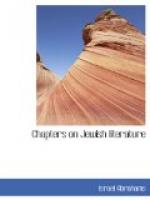CHAPTER XVII
THE ZOHAR AND LATER MYSTICISM
Kabbala.—The
Bahir.—Abulafia.—Moses of Leon.—The
Zohar.—Isaac
Lurya.—Isaiah Hurwitz.—Christian
Kabbalists.—The
Chassidim.
Mysticism is the name given to the belief in direct, intuitive communion with God. All true religion has mystical elements, for all true religion holds that man can commune with God, soul with soul. In the Psalms, God is the Rock of the heart, the Portion of the cup, the Shepherd and Light, the Fountain of Life, an exceeding Joy. All this is, in a sense, mystical language. But mysticism has many dangers. It is apt to confuse vague emotionalism and even hysteria with communion with God. A further defect of mysticism is that, in its medieval forms, it tended to the multiplication of intermediate beings, or angels, which it created to supply the means for that communion with God which, in theory, the mystics asserted was direct. Finally, from being a deep-seated, emotional aspect of religion, mysticism degenerated into intellectual sport, a play with words and a juggling with symbols.
Jewish mysticism passed through all these stages. Kabbala—as mysticism was called—really means “Tradition,” and the name proves that the theory had its roots far back in the past. It has just been said that there is mysticism in the Psalms. So there is in the idea of inspiration, the prophet’s receiving a message direct from God with whom he spoke face to face. After the prophetic age, Jewish mysticism displayed itself in intense personal religiousness, as well as in love for Apocalyptic, or dream, literature, in which the sleeper could, like Daniel, feel himself lapped to rest in the bosom of God.
All the earlier literary forms of mysticism, or theosophy, made comparatively little impression on Jewish writers. But at the beginning of the thirteenth century a great development took place in the “secret” science of the Kabbala. The very period which produced the rationalism of Maimonides gave birth to the emotionalism of the Kabbala. The Kabbala was at first a protest against too much intellectualism and rigidity in religion. It reclaimed religion for the heart. A number of writers more or less dallied with the subject, and then the Kabbala took a bolder flight. Ezra, or Azriel, a teacher of Nachmanides, compiled a book called “Brilliancy” (Bahir) in the year 1240. It was at once regarded as a very ancient book. As will be seen, the same pretence of antiquity was made with regard to another famous Kabbalistic work of a later generation. Under Todros Abulafia (1234-1304) and Abraham Abulafia (1240-1291), the mystical movement took a practical shape, and the Jewish masses were much excited by stories of miracles performed and of the appearance of a new Messiah.




